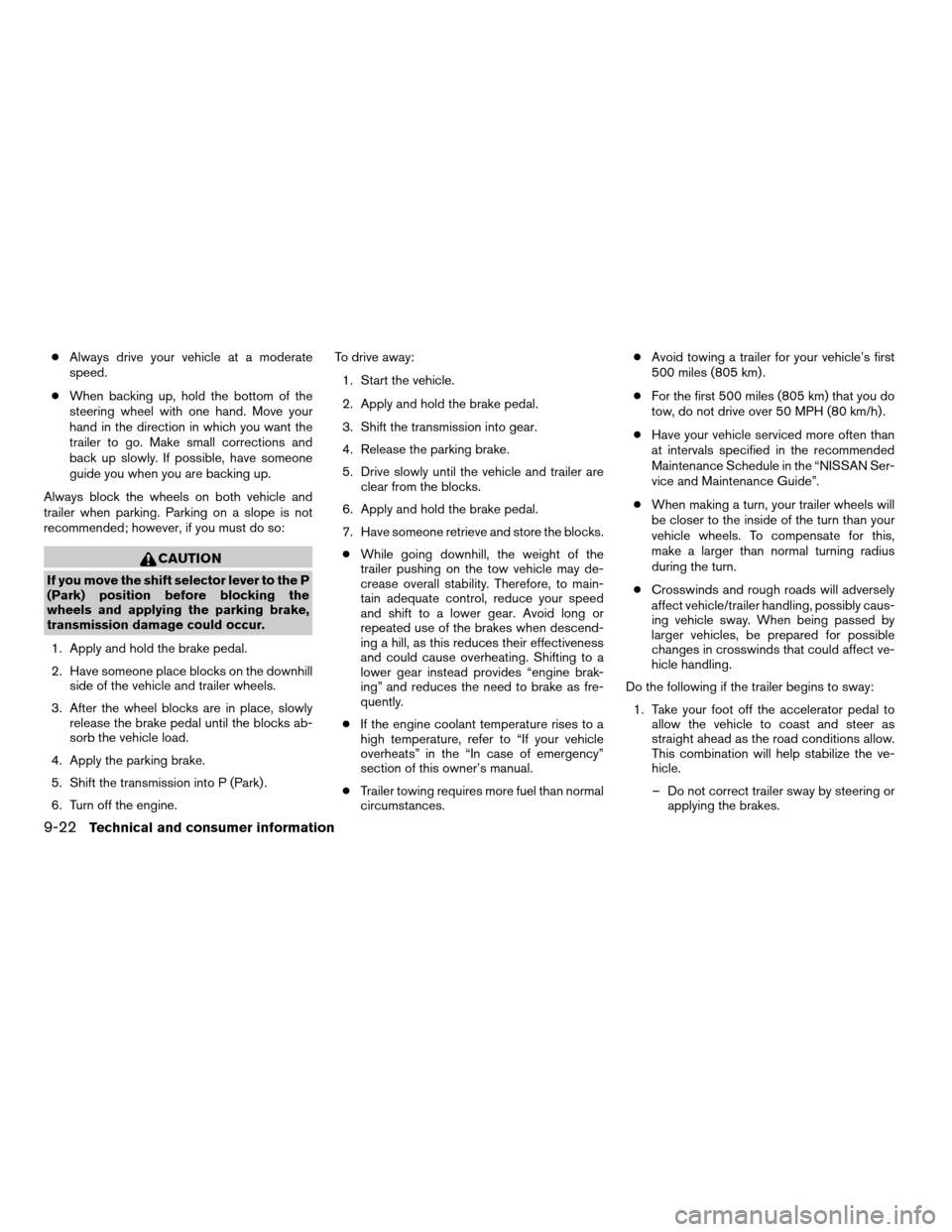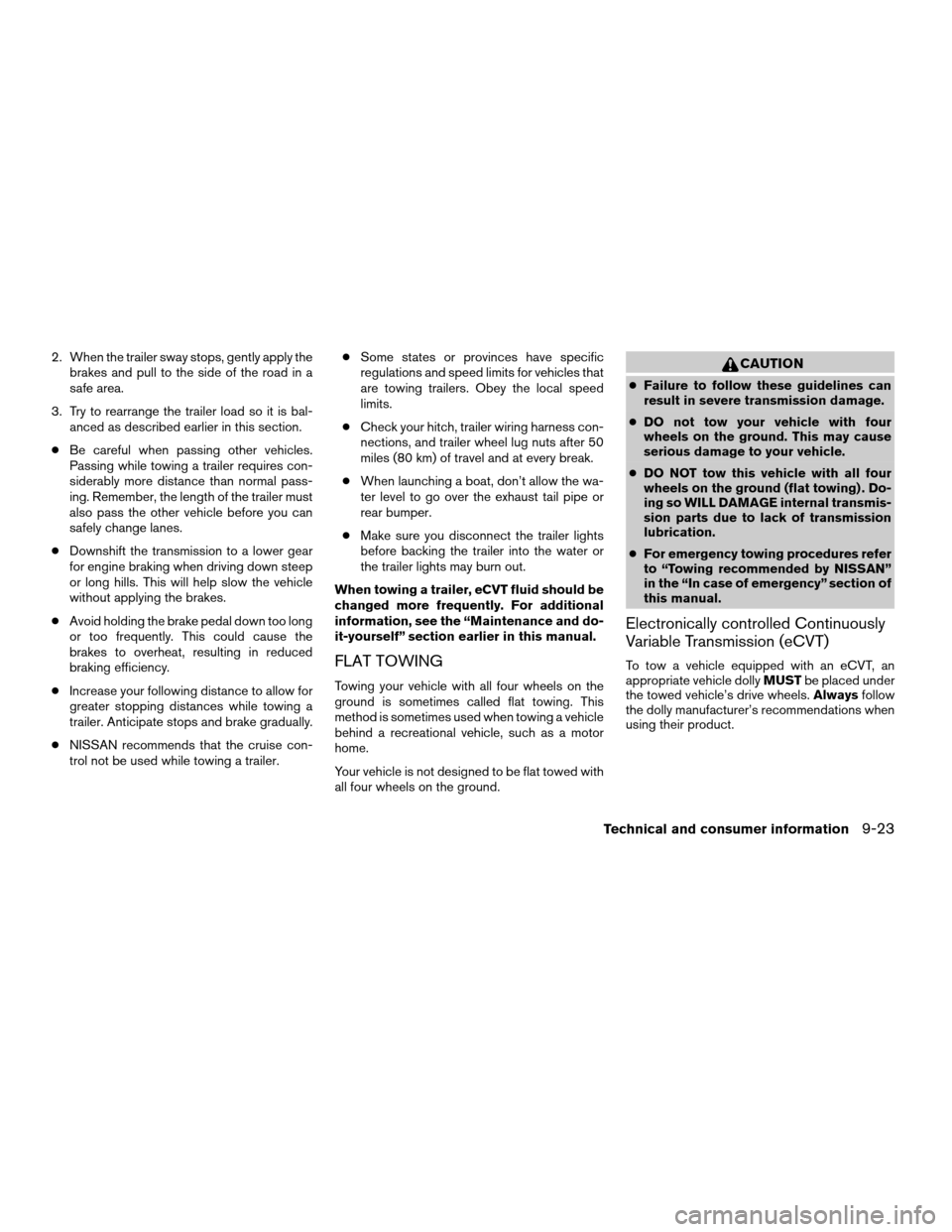2009 NISSAN ALTIMA HYBRID towing
[x] Cancel search: towingPage 339 of 353

cAlways drive your vehicle at a moderate
speed.
cWhen backing up, hold the bottom of the
steering wheel with one hand. Move your
hand in the direction in which you want the
trailer to go. Make small corrections and
back up slowly. If possible, have someone
guide you when you are backing up.
Always block the wheels on both vehicle and
trailer when parking. Parking on a slope is not
recommended; however, if you must do so:
CAUTION
If you move the shift selector lever to the P
(Park) position before blocking the
wheels and applying the parking brake,
transmission damage could occur.
1. Apply and hold the brake pedal.
2. Have someone place blocks on the downhill
side of the vehicle and trailer wheels.
3. After the wheel blocks are in place, slowly
release the brake pedal until the blocks ab-
sorb the vehicle load.
4. Apply the parking brake.
5. Shift the transmission into P (Park) .
6. Turn off the engine.To drive away:
1. Start the vehicle.
2. Apply and hold the brake pedal.
3. Shift the transmission into gear.
4. Release the parking brake.
5. Drive slowly until the vehicle and trailer are
clear from the blocks.
6. Apply and hold the brake pedal.
7. Have someone retrieve and store the blocks.
cWhile going downhill, the weight of the
trailer pushing on the tow vehicle may de-
crease overall stability. Therefore, to main-
tain adequate control, reduce your speed
and shift to a lower gear. Avoid long or
repeated use of the brakes when descend-
ing a hill, as this reduces their effectiveness
and could cause overheating. Shifting to a
lower gear instead provides “engine brak-
ing” and reduces the need to brake as fre-
quently.
cIf the engine coolant temperature rises to a
high temperature, refer to “If your vehicle
overheats” in the “In case of emergency”
section of this owner’s manual.
cTrailer towing requires more fuel than normal
circumstances.cAvoid towing a trailer for your vehicle’s first
500 miles (805 km) .
cFor the first 500 miles (805 km) that you do
tow, do not drive over 50 MPH (80 km/h) .
cHave your vehicle serviced more often than
at intervals specified in the recommended
Maintenance Schedule in the “NISSAN Ser-
vice and Maintenance Guide”.
cWhen making a turn, your trailer wheels will
be closer to the inside of the turn than your
vehicle wheels. To compensate for this,
make a larger than normal turning radius
during the turn.
cCrosswinds and rough roads will adversely
affect vehicle/trailer handling, possibly caus-
ing vehicle sway. When being passed by
larger vehicles, be prepared for possible
changes in crosswinds that could affect ve-
hicle handling.
Do the following if the trailer begins to sway:
1. Take your foot off the accelerator pedal to
allow the vehicle to coast and steer as
straight ahead as the road conditions allow.
This combination will help stabilize the ve-
hicle.
– Do not correct trailer sway by steering or
applying the brakes.
9-22Technical and consumer information
ZREVIEW COPYÐ2009 Altima Hybrid Electric
(ahv)
Owners ManualÐCanadian_French(fr_can)
06/16/08Ðdebbie
X
Page 340 of 353

2. When the trailer sway stops, gently apply the
brakes and pull to the side of the road in a
safe area.
3. Try to rearrange the trailer load so it is bal-
anced as described earlier in this section.
cBe careful when passing other vehicles.
Passing while towing a trailer requires con-
siderably more distance than normal pass-
ing. Remember, the length of the trailer must
also pass the other vehicle before you can
safely change lanes.
cDownshift the transmission to a lower gear
for engine braking when driving down steep
or long hills. This will help slow the vehicle
without applying the brakes.
cAvoid holding the brake pedal down too long
or too frequently. This could cause the
brakes to overheat, resulting in reduced
braking efficiency.
cIncrease your following distance to allow for
greater stopping distances while towing a
trailer. Anticipate stops and brake gradually.
cNISSAN recommends that the cruise con-
trol not be used while towing a trailer.cSome states or provinces have specific
regulations and speed limits for vehicles that
are towing trailers. Obey the local speed
limits.
cCheck your hitch, trailer wiring harness con-
nections, and trailer wheel lug nuts after 50
miles (80 km) of travel and at every break.
cWhen launching a boat, don’t allow the wa-
ter level to go over the exhaust tail pipe or
rear bumper.
cMake sure you disconnect the trailer lights
before backing the trailer into the water or
the trailer lights may burn out.
When towing a trailer, eCVT fluid should be
changed more frequently. For additional
information, see the “Maintenance and do-
it-yourself” section earlier in this manual.
FLAT TOWING
Towing your vehicle with all four wheels on the
ground is sometimes called flat towing. This
method is sometimes used when towing a vehicle
behind a recreational vehicle, such as a motor
home.
Your vehicle is not designed to be flat towed with
all four wheels on the ground.
CAUTION
cFailure to follow these guidelines can
result in severe transmission damage.
cDO not tow your vehicle with four
wheels on the ground. This may cause
serious damage to your vehicle.
cDO NOT tow this vehicle with all four
wheels on the ground (flat towing) . Do-
ing so WILL DAMAGE internal transmis-
sion parts due to lack of transmission
lubrication.
cFor emergency towing procedures refer
to “Towing recommended by NISSAN”
in the “In case of emergency” section of
this manual.
Electronically controlled Continuously
Variable Transmission (eCVT)
To tow a vehicle equipped with an eCVT, an
appropriate vehicle dollyMUSTbe placed under
the towed vehicle’s drive wheels.Alwaysfollow
the dolly manufacturer’s recommendations when
using their product.
Technical and consumer information9-23
ZREVIEW COPYÐ2009 Altima Hybrid Electric
(ahv)
Owners ManualÐCanadian_French(fr_can)
06/16/08Ðdebbie
X
Page 351 of 353

Automatic power window switch.....2-43
Fog light switch...............2-33
Hazard warning flasher switch.......2-33
Headlight and turn signal switch......2-29
Headlight control switch..........2-29
Power door lock switch...........3-5
Rear window and outside mirror defroster
switch....................2-29
Turn signal switch..............2-33
Windshield wiper and washer switch . . .2-28
T
Theft (NISSAN vehicle immobilizer system) ,
engine start..............2-27, 3-3, 5-9
Three-way catalyst................5-3
Tire
Flat tire....................6-2
Spare tire................6-3, 8-40
Tire and Loading Information label.....9-11
Tire chains..................8-37
Tire placard.................9-11
Tire pressure................8-29
Tire rotation.................8-38
Types of tires................8-36
Uniform tire quality grading.........9-24
Wheels and tires..............8-29
Wheel/tire size................9-8
Tire pressure
Low tire pressure warning light......2-13
Tire Pressure Monitoring System (TPMS) . . .5-3
Top tether strap child restraint.........1-18
Towing
Flat towing..................9-23
Tow truck towing..............6-12Towing load/specification.........9-19
Trailer towing................9-16
Transceiver
HomeLinkTUniversal Transceiver.....2-48
Transmission
Driving with Electronically controlled
Continuously Variable Transmission
(eCVT)....................5-11
Electronically controlled Continuously
Variable Transmission (eCVT) fluid. . . .8-13
Selector lever lock release.........5-13
Travel (See registering your vehicle in
another country).................9-9
Trip odometer...................2-4
Troubleshooting guide
(NISSAN voice recognition system)......4-67
Trunk lid lock opener lever...........3-18
Trunk light....................2-48
Turn signal switch................2-33
U
Uniform tire quality grading...........9-24
V
Vanity mirror...................3-24
Vehicle
Before starting the vehicle.........5-10
Speed sensing door lock mechanism. . . .3-6
Starting the vehicle.............5-10
Vehicle dimensions and weights........9-8
Vehicle does not start..............6-8
Vehicle dynamic control (VDC) system. . . .5-23Vehicle identification...............9-9
Vehicle identification number (VIN)
(Chassis number).................9-9
Vehicle identification number (VIN) plate. . . .9-9
Vehicle loading information...........9-12
Vehicle recovery.................6-14
Vehicle security system.............2-26
Vehicle security system (NISSAN vehicle
immobilizer system) , engine start . .2-27, 3-3, 5-9
Visors......................3-23
Voice recognition system............4-63
W
Warning
Air bag warning light.........1-49, 2-15
Anti-lock brake warning light........2-10
Battery charge warning light. . . .2-11, 2-13
Brake warning light.........2-10, 2-12
Engine oil pressure warning light.....2-12
Hazard warning flasher switch.......2-33
Low fuel warning light. . . .2-13, 2-14, 2-24
Low tire pressure warning light......2-13
Low washer fluid warning light.......2-24
Passenger air bag and status light.....1-43
Seat belt warning light...........2-14
Vehicle security system...........2-26
Warning labels (for SRS)..........1-48
Warning/indicator lights and audible
reminders...................2-9
Warning lights..................2-9
Washer switch
Windshield wiper and washer switch . . .2-28
Weights (See dimensions and weights). . . .9-8
Wheels and tires................8-29
10-6
ZREVIEW COPYÐ2009 Altima Hybrid Electric
(ahv)
Owners ManualÐCanadian_French(fr_can)
06/16/08Ðdebbie
X